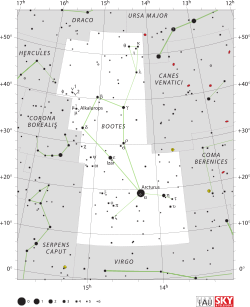Ny1 Bootis
| Ny1 Bootis (ν1) | |
 | |
| Observationsdata Epok: J2000 | |
|---|---|
| Stjärnbild | Björnvaktaren |
| Rektascension | 15t 30m 55,75s[1] |
| Deklination | +40° 49′ 59,0″[1] |
| Skenbar magnitud () | 5,02[2] |
| Stjärntyp | |
| Spektraltyp | K4.5 IIIb Ba0.4[3] |
| U–B | +1,91[2] |
| B–V | +1,59[2] |
| Astrometri | |
| Radialhastighet () | -11,2 ± 0,16[4] km/s |
| Egenrörelse (µ) | RA: -13,73[5] mas/år Dek.: -14,92[5] mas/år |
| Parallax () | 7,59 ± 0,55[5] |
| Avstånd | 430 ± 30 lå (132 ± 10 pc) |
| Absolut magnitud () | -2,22[6] |
| Detaljer | |
| Radie | 38 ± 2[7] R☉ |
| Luminositet | 1 626[8] L☉ |
| Temperatur | 3 917 ± 27[9] K |
| Metallicitet | +0,00 ± 0,06[9] dex |
| Vinkelhastighet | 4,2[10] km/s |
| Andra beteckningar | |
| v1 Boo, 52 Bootis, BD+41° 2609, FK5 573, GC 20866, HD 138481, HIP 75973, HR 5763, SAO 45580 [11] | |
Ny1 Bootis (ν1 Bootis, förkortad Ny1 Boo, ν1 Boo), som är stjärnans Bayer-beteckning, är en ensam stjärna i nordöstra delen av stjärnbilden Björnvaktaren. Den har en skenbar magnitud av 5,02[2] och är synlig för blotta ögat där ljusföroreningar ej förekommer. Baserat på parallaxmätning inom Hipparcosuppdraget på ca 7,6 mas,[5] beräknas den befinna sig på ett avstånd av ca 430 ljusår (132 parsek) från solen. På det beräknade avståndet minskar stjärnans skenbara magnitud med 0,13 enheter genom en skymningsfaktor på grund av interstellärt stoft.[12]
Egenskaper[redigera | redigera wikitext]
Ny1 Bootis är en orange till röd jättestjärna av spektralklass K4.5 IIIb Ba0.4[3] "Ba0.4"-suffixet anger att den är en bariumstjärna[13], vilket innebär att stjärnans yttre atmosfär har förstärkts med s-processelement som sannolikt kommer från det som nu är en omkretsande vit följeslagare.[14] Den har en radie som är ca 38[7] gånger solens radie och avger ca 1 630[8] gånger mer energi än solen från dess fotosfär vid en effektiv temperatur på ca 3 900 K.[9]
Referenser[redigera | redigera wikitext]
- Den här artikeln är helt eller delvis baserad på material från engelskspråkiga Wikipedia, 10 april 2019.
Noter[redigera | redigera wikitext]
- ^ [a b] «Object query : HD 138481». Simbad (em inglês). Consultado em 8 de agosto de 2012
- ^ [a b c d] Johnson, H. L.; et al. (1966), "UBVRIJKL photometry of the bright stars", Communications of the Lunar and Planetary Laboratory, 4 (99), Bibcode:1966CoLPL...4...99J.
- ^ [a b] Keenan, Philip C.; McNeil, Raymond C. (1989), "The Perkins catalog of revised MK types for the cooler stars", Astrophysical Journal Supplement Series, 71: 245, Bibcode:1989ApJS...71..245K, doi:10.1086/191373.
- ^ de Bruijne, J. H. J.; Eilers, A.-C. (October 2012), "Radial velocities for the HIPPARCOS-Gaia Hundred-Thousand-Proper-Motion project", Astronomy & Astrophysics, 546: 14, arXiv:1208.3048, Bibcode:2012A&A...546A..61D, doi:10.1051/0004-6361/201219219, A61.
- ^ [a b c d] van Leeuwen, F. (2007), "Validation of the new Hipparcos reduction", Astronomy and Astrophysics, 474 (2): 653–664, arXiv:0708.1752, Bibcode:2007A&A...474..653V, doi:10.1051/0004-6361:20078357.
- ^ Schiavon, Ricardo P. (July 2007), "Population Synthesis in the Blue. IV. Accurate Model Predictions for Lick Indices and UBV Colors in Single Stellar Populations", The Astrophysical Journal Supplement Series, 171 (1): 146–205, arXiv:astro-ph/0611464, Bibcode:2007ApJS..171..146S, doi:10.1086/511753.
- ^ [a b] Nordgren, Tyler E.; et al. (December 1999), "Stellar Angular Diameters of Late-Type Giants and Supergiants Measured with the Navy Prototype Optical Interferometer", The Astronomical Journal, 118 (6): 3032–3038, Bibcode:1999AJ....118.3032N, doi:10.1086/301114.
- ^ [a b] McDonald, I.; et al. (2012), "Fundamental Parameters and Infrared Excesses of Hipparcos Stars", Monthly Notices of the Royal Astronomical Society, 427 (1): 343–57, arXiv:1208.2037, Bibcode:2012MNRAS.427..343M, doi:10.1111/j.1365-2966.2012.21873.x.
- ^ [a b c] Prugniel, Ph.; et al. (July 2011), "The atmospheric parameters and spectral interpolator for the MILES stars", Astronomy & Astrophysics, 531: A165, arXiv:1104.4952, Bibcode:2011A&A...531A.165P, doi:10.1051/0004-6361/201116769.
- ^ De Medeiros, J. R.; et al. (November 2000), "Rotation and lithium in single giant stars", Astronomy and Astrophysics, 363: 239–243, arXiv:astro-ph/0010273, Bibcode:2000A&A...363..239D.
- ^ "nu01 Boo". SIMBAD. Centre de données astronomiques de Strasbourg. Hämtad 2017-09-09.
- ^ Famaey, B.; et al. (January 2005), "Local kinematics of K and M giants from CORAVEL/Hipparcos/Tycho-2 data. Revisiting the concept of superclusters", Astronomy and Astrophysics, 430 (1): 165–186, arXiv:astro-ph/0409579, Bibcode:2005A&A...430..165F, doi:10.1051/0004-6361:20041272.
- ^ Gomez, A. E.; et al. (1997), "Absolute magnitudes and kinematics of barium stars", Astronomy and Astrophysics, 319: 881, Bibcode:1997A&A...319..881G.
- ^ Eggleton, P. P.; Tokovinin, A. A. (September 2008), "A catalogue of multiplicity among bright stellar systems", Monthly Notices of the Royal Astronomical Society, 389 (2): 869–879, arXiv:0806.2878, Bibcode:2008MNRAS.389..869E, doi:10.1111/j.1365-2966.2008.13596.x.





